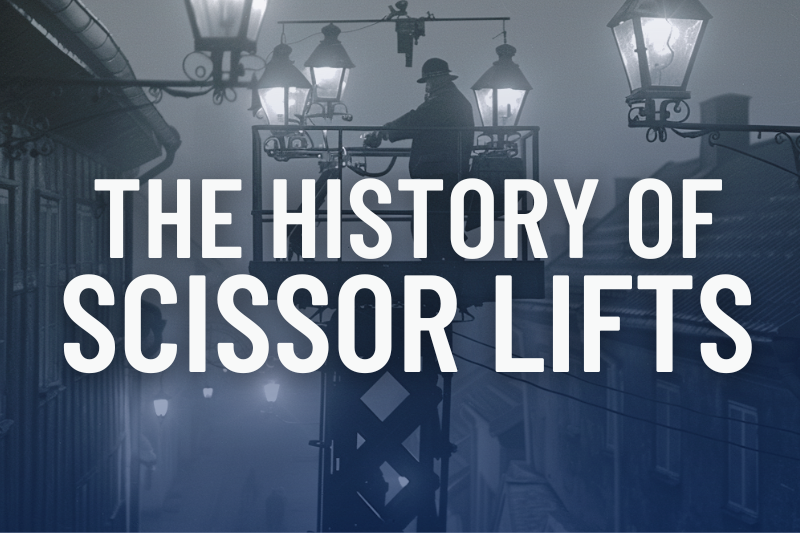
It's easy to think the equipment we depend on simply sprang into existence, fully formed. Yet, modern material handling equipment is the culmination of over a century of tireless innovation and experimentation by those who saw problems in our world and sought to create a solution.
The scissor lift is one such invention. Emerging at a time when workers had far fewer protections than today, this now commonplace machine revolutionized aerial lift equipment. Read on to discover how scissor lifts took material handling to new heights.
Origins
 In the 1920s Sweden, streetlights were a problem. Introduced in the 16th century, streetlights pushed back the night and reduced violent crime in urban settings. Over the centuries, they became an almost universal feature of cities worldwide. However, with the introduction of electric lighting, millions of light bulbs suddenly needed changing. Between the end of the 1800s and the first quarter of the 1900s, workers climbed a ladder, removed the globe, changed the bulb by hand, and climbed back down before repeating the process for every streetlight.
In the 1920s Sweden, streetlights were a problem. Introduced in the 16th century, streetlights pushed back the night and reduced violent crime in urban settings. Over the centuries, they became an almost universal feature of cities worldwide. However, with the introduction of electric lighting, millions of light bulbs suddenly needed changing. Between the end of the 1800s and the first quarter of the 1900s, workers climbed a ladder, removed the globe, changed the bulb by hand, and climbed back down before repeating the process for every streetlight.
Ladder falls became such a serious concern that Swedish cities installed hydraulic lifts on the back of automobiles, giving workers a stable platform on which to work. These mobile elevated working platforms (MEWPs) relied on long hydraulic pistons with telescoping scaffolding to achieve height.
By 1963, Charles Larson believed he could improve on the design. His patent application described "an extensible lift mechanism for elevating a load.
Of his design, he wrote, "This invention relates to such mechanism including an opposed pair of scissor mechanisms, each of which includes a pair of scissor arms pivotally connected together, where relative pivotal movement of the arms accompanies extension of the lift mechanism."
With the approval of that application, the modern scissor lift was born.
Mass Production
In the second half of the 1960s, John W. Parker of California took Mr. Larson's design a step further. The original patent outlined a tow-behind model requiring a separate vehicle to move about. Mr. Parker helped devise a self-propelled scissor lift that used an IC engine for motive power. IC engines would remain the standard for the next 30 years.
In the mid-1970s, Parker’s Parkerlift scissor lifts and models like it from competitors JLG and MEC went into mass production. This style of MEWP scissor lift grew increasingly popular throughout the United States. Their success prompted many other equipment manufacturers to develop and produce their own models.
This period brought about near-constant improvements in the technology. MEC, for example, introduced their popular pothole protection system. Competitors raced to build larger and taller models. In the early 1990s, the first scissor lifts extending above 25 feet entered the market.
Advancing Technology
The turn of the millennium heralded new advancements in aerial lifting equipment. Improvements in electric motors and batteries brought about the world’s first hybrid scissor lifts. These models combined traditional lift hydraulics with new electric driving and steering. These lifts were easier to manage on the job site, making them popular as construction scissor lifts.
The first all-electric scissor lift entered the market in 2021. This model and others like it finally eliminated all hydraulic components, relying entirely on electric motors. All-electric models proved more environmentally friendly than their hydraulic counterparts.
Today, scissors lifts are more popular than ever. The diversity of models allows for both indoor and outdoor use. Advancements in technology have also extended heights, with some indoor models reaching almost 45 feet and their outdoor counterparts closing in on 60 feet.
Modern Regulations
As scissor lifts gained popularity, accident reporting revealed a need for universal safety standards for all MEWPs. In 2020, the American National Standards Institute (ANSI) introduced standard A92.20. It established several new requirements for scissor lift manufacturers, including live load sensors, increased testing standards, and taller guard rails. Furthermore, standard A92.24 established the requirement for training aerial equipment operators, occupants, and supervisors to improve scissor lift safety.
The Scissor Lift Experts
Established in 1919, The Lilly Company predates even the earliest scissor lifts. Our history took us from the painting industry to the ice industry and, by 1952, into the material handling industry. Our over 70 years of material handling experience have made us experts in aerial equipment. If you’re looking to discover what scissor lifts can do for your operation, let us help. To learn more about scissor lifts or any of our aerial equipment solutions, contact us online or visit one of our locations:
Arkansas - Jonesboro
Alabama - Birmingham, Dothan, Irondale, Madison, Mobile, and Montgomery
Mississippi - Tupelo and Richland
Tennessee - Jackson, Memphis, Knoxville, and Kingsport
Further Reading
- Product Review: AICHI Vertical Mast Lift
- Ladder Safety: Can Your Business Afford a Lawsuit or OSHA Citation
- What You Need to Know Before Buying or Renting a Scissor Lift

Posts by Tag
- Forklift (61)
- Forklift Service (19)
- Electric Forklifts (16)
- Forklift Safety (14)
- Forklift Attachments (12)
- Toyota Forklifts (12)
- Warehouse Planning (10)
- Parts (9)
- Warehouse Automation (8)
- Clark Forklifts (7)
- Loading Docks (7)
- Material Handling Education (7)
- Pallet Racking (7)
- Customer Solutions (6)
- Forklift Batteries (6)
- Forklift Rental (6)
- Purchasing Options (6)
- Aerial Equipment (5)
- Heavy Equipment (5)
- Forklift Accessories (4)
- Forklift Fleet Management (4)
- Forklift Tires (4)
- Forklift Training (4)
- Products (4)
- Utility Vehicles (4)
- Yard Spotter Trucks (4)
- Linde (3)
- Pallet Jacks (3)
- Specialty Forklifts (3)
- Used Equipment (3)
- IC Forklifts (2)
- Manitou (2)
- Warehouse Doors (2)
- COMBiLift (1)
- Custom Shop (1)
- Forklift Brakes (1)
- Forklift Warranty (1)
- Gehl (1)
- Komatsu (1)
- Product Review (1)
- Recruitment (1)










